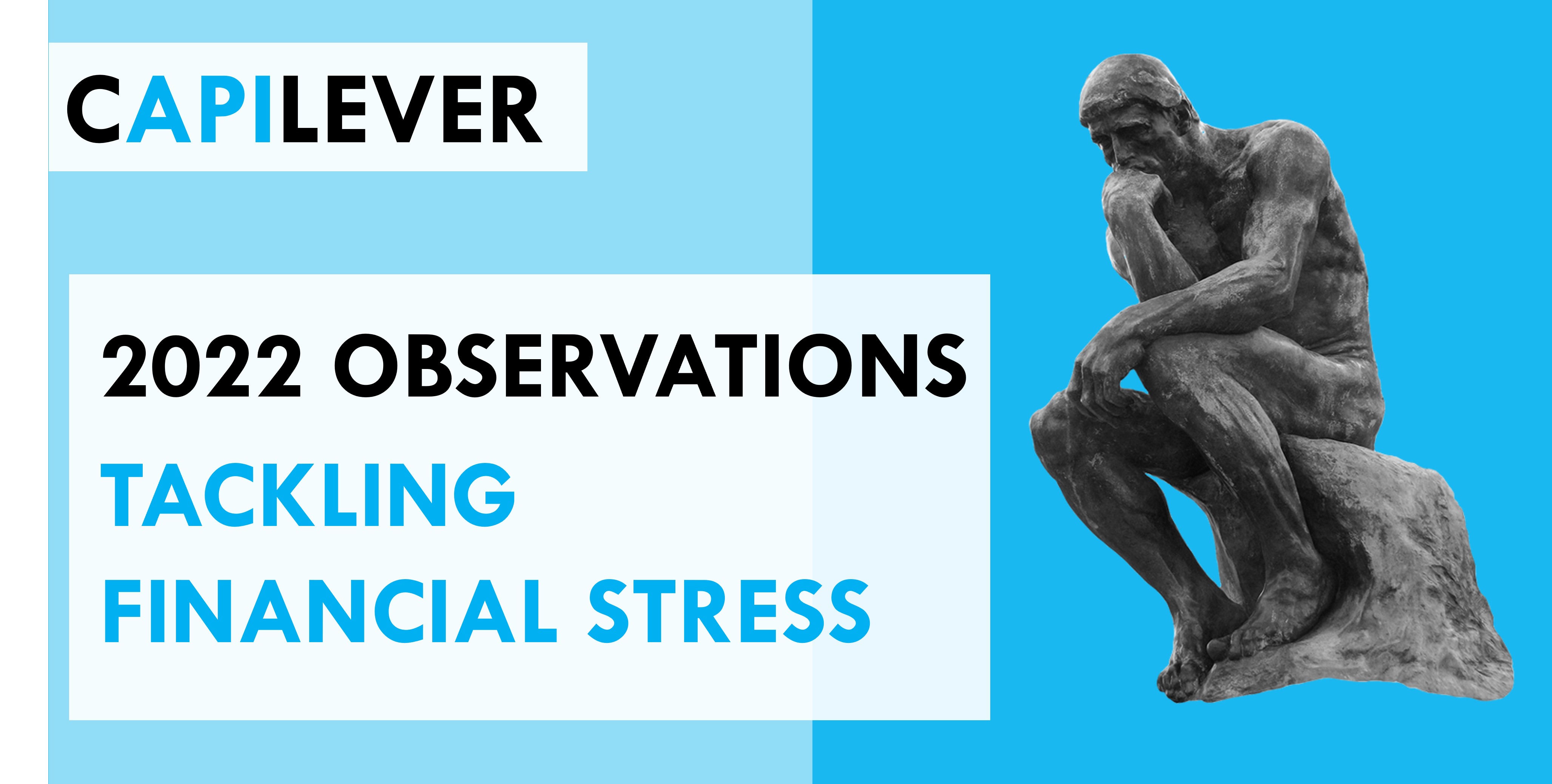2022 market review for tackling financial stress
8 January 2023
What do Wise, Curve, Qover, Monese and Capilever have in common? Besides being Fintechs active in the financial services sector you will probably say not that much, but when you look at their recent product announcements you can see a common line, i.e. they are all working on features to remove financial stress. And with financial stress we don’t mean the lack of money which numerous people face today, but rather the stress related to the continuous follow-up and decision taking involved in sound financial management.
Focus on liquidity management as source of stress
We at Capilever believe financial institutions should reduce financial stress by automatically proposing the right financial products at the right moment.
A financial action that gives many consumers financial stress is liquidity management. Liquidity management is hard, as you need to predict your upcoming incoming and outgoing cashflows, and when you get it wrong it comes at a high cost, i.e. :
- In case you forecasted a more positive cash flow, you get cash shortages, meaning medium- to long-term investments need to be pre-maturely liquidated (which might not be possible in time if the investments are not liquid enough and/or could be at a very bad moment), new credits need to be originated or existing (expensive) credit lines need to be consumed
- In case you forecasted a more negative cash flow, you get a cash excess, which comes with an opportunity cost, i.e. you would have been better off if you had invested this excess money already
Very few people, and even companies, manage liquidity forecasting well, which is perfectly understandable as it requires a continuous follow-up of your finances and good insights in your cash flows, which is something most people and companies don’t have the time, the skills or the adequate tooling for.
Many banks and B2C Fintechs offer tools to gain insights in your past income and expenses and allow to define future budget plans, via so-called personal finance management (PFM) tools. Even though these can definitely help to improve your financial management, they often increase your financial stress, as they give even more pressure to take all kinds of financial decisions, trying to manually optimize your budget.
A next generation of personal financial management tools should offer automatic financial products to manage your finances for you, i.e. automatic cash flow smoothing. Additionally those products will be more and more embedded in your day-to-day user journeys (like embedded in the checkout process), allowing a customer to really outsource financial management, and more particularly liquidity management, to their financial institution.

Initiatives in the market
In recent months, we could read a number of interesting initiatives and evolutions going in that direction, e.g. :
- Wise (formerly TransferWise) has come up with a unique offering where all money on a Wise account can be automatically invested in a well-diversified (not too risky) mutual fund of Blackrock. This means that if you have money parked on a Wise account, automatically it will get invested in this mutual fund. The money however keeps the same liquidity, as the money invested in this mutual fund can still be transferred immediately. This means a customer does not first have to sell (in full or partially) their mutual fund investment and wait for a few days, but rather they can transfer immediately a certain amount (behind the scenes this mutual fund is sold and an advance is given by Wise while awaiting the settlement).
This means the customer has a higher return on their money, while keeping the same level of liquidity. - Curve has come up with a new form of consumer credit called their FLEX solution, which they market as a buy now pay later (BNPL) offer, although the origination is not really happening in the checkout process. This product also allows a more flexible liquidity management. The new offer allows customers to adapt their payment method for an item even a few days after buying it. E.g. suppose you paid a laptop with your debit card, Curve FLEX allows to adapt this to a BNPL payment, where the customer will be able to gradually pay for their laptop. This means if a customer misjudged their available liquidity, they can still adapt retro-actively.
- Capilever provides 2 solutions to reduce financial stress, i.e. the FLEX solution which is a combination of a long-term credit and investment product, which allows to smooth out fluctuations and imbalances in your (short- and long-term) cash flows; and the Lombard² solution, which allows to generate immediate liquidity via a credit, using your medium- to long-term investments as a collateral.
- Monese has come up with a new offering in partnership with Qover, allowing to open an insurance in a very simple and user-friendly way, based on your account transaction history. The product called Bills Protection allows you to insure against illness, an accident or unemployment for all your (fixed) recurring payments.
- ING partnered a few years ago with Minna Technologies to manage subscription services in a much easier way (offering called “OneView”). This allows customers to manage, improve and/or stop their subscriptions (like gas, electricity, streaming services, fitness, etc.) very easily, which again helps to better manage your liquidity.
All these initiatives are a step in the right direction, but ultimately your financial institution should take most of these decisions related to liquidity management for you. This means customers will not need to move money around anymore between their current, saving and term accounts and will no longer need to choose between different credit products with different objectives and horizons. Instead the traditional bank domain lines between Daily Banking, Investments and Credits will blur, as all will be integrated in 1 automated liquidity management financial product.

